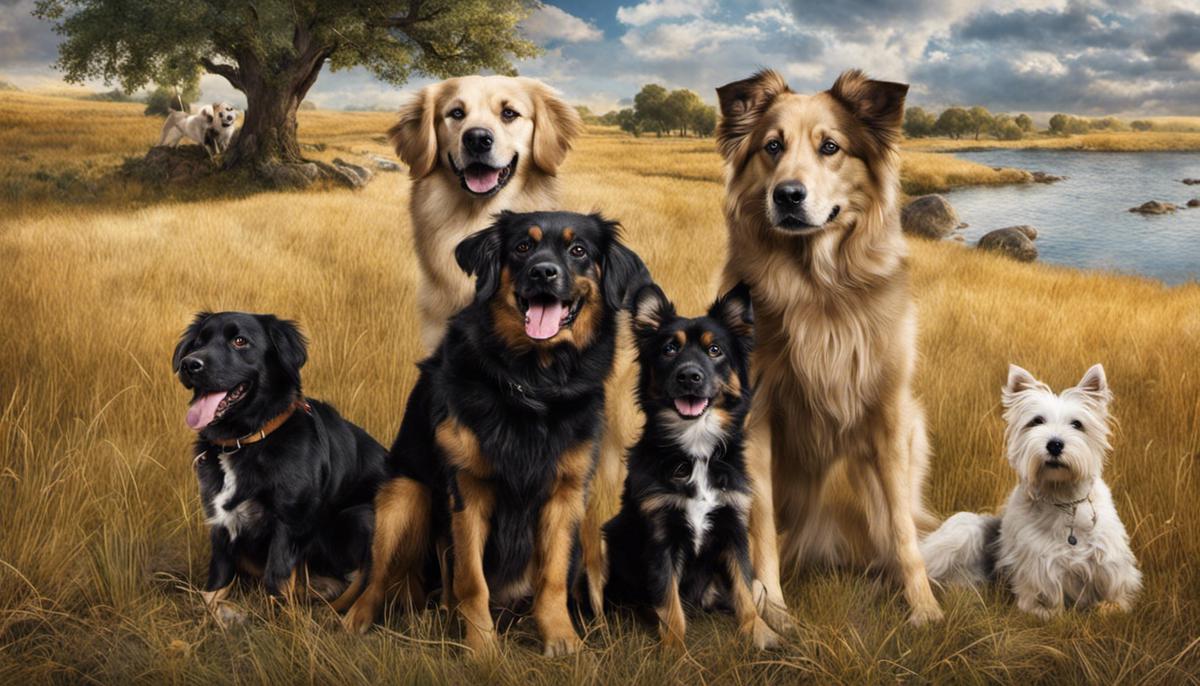From earliest civilization, dreams have held a potent fascination as potential windows into the unexplained realms and cryptic messages from the divine. Positioned at the intersection of the spiritual and the psychological, dream interpretation offers an intriguing path to the unveiling of subconscious truths or future possibilities. When the lens of biblical symbolism is applied to the dreamscape, this interpretation can carry profound spiritual meaning. This exploration focuses on the interpretation of puppies in dreams within a biblical context, commencing with a retrospective dive into the historical foundations of biblical dream interpretation, before delving into the biblical connotations of dogs, and moving into an analysis of puppies as symbols in dream imagery, and finally linking these strands for an in-depth interpretation of puppies in dreams.
Historical Context of Biblical Dream Interpretation
In the hands of a scholar devoted to the meticulous analysis of the evolution of dream interpretation within a biblical context, the vast myriad of subtopics and intricacies which lay beneath the surface make an enduring discourse.
Prima facie, the Bible presents an abundant assortment of dreams, presented as divine revelations or prophetic visions. Notably, the biblical text dedicates essential plot development to dreams. Take Joseph and his multi-colored coat, or Daniel interpreting the dreams of Nebuchadnezzar as prime examples.
Early biblical texts largely present dreams as a designated channel of communication between God and selected individuals. In the Old Testament, dreams were considered a divine language, a conduit via which God imparted messages and warnings to prophets and leaders. For instance, consider the dreams of Pharaoh in the Book of Genesis, interpreted by Joseph to reveal seven years of prosperity, followed by seven years of famine.
Furthermore, the examination of prophetic dreams in the Old Testament brings to the forefront elements of vivid symbolism. In the Book of Daniel, beasts rise from the sea, horned rams and goats engage in combat, all interpreted to foretell specific historical events.
In contrast, the New Testament witnesses a shift in the narrative function of dreams. The dreams became more literal in nature, less tangled with convoluted metaphors and symbols. Direct divine guidance, warnings, and revelations became the principal function, as seen in the dreams of Joseph pertaining to the birth and safety of Jesus.
As we traverse through the Middle Ages and beyond, there is a conspicuous decrease in the influence of dreams in general biblical interpretation. Scholars and theologians began to view dreams as a less credible source of divine guidance. This corresponded with the burgeoning scientific rationalism of the Age of Enlightenment.
On the contrary, towards the end of the 19th century and the advent of psychoanalysis, new perspectives emerged on dreams in the biblical context. Sigmund Freud and Carl Jung, through the prism of psychoanalysis, viewed dreams as the royal road to the unconscious. Although their methodology was secular and did not directly deal with biblical text, their theories influenced biblical dream interpretation, emphasizing on the unconscious, symbolic, and personal references hidden in dreams.
Undeniably, the path of dream interpretation in biblical context has not tread a linear course. It is characterized by oscillating views, marking the interplay of diverse cultural, scientific, philosophical, and religious paradigms over centuries. Despite these vacillations, dream narratives remain embedded within the biblical text, continuing to fascinate and provoke contemplation from ever-curious scholars, theologians, and laymen alike.

Specific Biblical Connotations of Puppies and Dogs
The roles bestowed upon many animals within the biblical corpus are indicative of prevailing cultural perceptions and practices of the time. In particular, dogs – and by extension, puppies – stand as a uniquely dichotomous symbol that warrants further examination. The treatment of dogs within biblical lore can appear perplexing and even at odds with modern cultural sentiment concerning these animals. Hence, it is essential to recognize these references as a construct of their temporal and cultural context.
Dogs feature in the Bible in predominantly negative connotations, often used as figures of scorn or contempt. In the time when the Bible was written, dogs were frequently viewed as unclean or dangerous, a stark contrast from modern sentiment where dogs are generally celebrated as beloved pets. Such ancient views may stem from dogs’ scavenging nature, often observed feeding off dead bodies or refuse.
Biblical references portraying dogs on the receiving end of human contempt include Proverbs 26:11: “As a dog returneth to his vomit, so a fool returneth to his folly,” and Isaiah 56:10-11, where Israel’s negligent watchmen are depicted as dogs that “cannot bark; dreaming, lying down, loving to slumber.” These verses convey the ignoble status of dogs and the abhorrence associated with their behavior.
Conversely, the field of biblical studies is hesitant to reduce dogs to mere symbols of disdain. The figure of a dog can also serve as a paradigm of loyalty and service. There has been some identification of the canaanite goddess Anat with a dog due to her appellation as the “lady of the serfs,” essentially functioning as a protective deity.
In the New Testament, Jesus refers to non-Jews as dogs, as seen in Matthew 15:21-28. However, through dialogical rapport with a Canaanite woman, Jesus breaks the boundaries of ethnocentrism and religious discrimination, which further illustrates the nuanced dog symbolism.
Fulfilling a different function, Revelation 22:15 expels dogs as a moral symbol, marginalizing them outside the heavenly city as representations of morally corrupt actions and individuals.
Dogs are thus employed in a largely metaphorical capacity within the biblical context. This anthropocentric utilization overlooks the intrinsic value attached to these animals and reduces them to symbols reflecting human moral, social and divine concerns.
The significance of dogs within biblical lore underscores the necessity of extricating the historical and cultural spheres within which the Bible emerged. This anthropological and theological endeavor enhances our understanding of biblical content and contributes to the comprehensive interpretive approach. By rigorous exploration of these symbolisms, we pave the way for a more profound grasp of the multi-dimensional biblical narrative.

Interpreting the Symbolism of Puppies in Dream Imagery
Pivoting towards the eventual confluence of these concepts, it is essential to analyze the phenomena of dreaming about puppies within the spheres of religious and psychological interpretation.
Puppies, or young dogs, within dreams materialize as a unified representation of innocence, companionship, and undertones of service, though it is worth understanding the absence of explicit directives regarding puppy dreams within the biblical text.
The subsequent interpretation, therefore, stems broadly from historical perspectives on dogs in biblical and cultural contexts.
The symbolism of puppies appeared elusive in ancient narratives; understanding such symbolism demands finely nuanced contextual excavations.
Thus, puppies within a dream could potentially inaugurate novel interpretations, founded upon their distinctly youthful qualities, such as innocence, playfulness, and trusting companionship.
From an anthropological viewpoint, both dogs and puppies symbolize loyalty, fidelity, and protective instincts.
The dreamer may find resounding echoes of these qualities expressed in their waking life relationships, flocking towards an all-encompassing approach in understanding biblical symbolism.
A dream of puppies might invoke the call to foster similar characteristics of loyalty, trust, and robust, protective companionship existing or desired, within their life dynamics.
Exploring this concept further under the scrutiny of psychology, particularly delving into the realm of Carl Jung’s analytical psychology, supports a different lens of interpretive conjecture.
As per Jungian theory, the symbol of a puppy in one’s dream might serve as an archetype, a primitive mental image inherited from the earliest human ancestors, embodying certain ideas and instincts.
Puppies could depict the individual’s playful, innocent, and instinctual aspects of their psyche, they might also stand as symbols of growth and transformation, considering a pup’s progression to an adult dog.
In a Freudian perspective, puppies could symbolize a longing for nurturing or being nurtured, given Freud’s emphasis on familial relationships.
It is crucial to note that these interpretations are not neatly segmented but encompass various facets of the dreamer’s conscious and unconscious psyche, with an interplay of emotions, experiences, and thoughts.
Merging religious and psychological interpretations, some consider dreams as a medium where divine and psychic elements interweave, allowing the divine to communicate with the individual subconscious.
In this hybrid interpretation, puppies might allude to the divine’s calling for the dreamer to incorporate qualities like innocence, camaraderie, and protection into their life journey, indicative of their spiritual evolution.
It is prudent to remember that dream symbols, especially one as complex as a puppy, are multi-layered.
Depending on the dreamer’s personal experiences and psychological inclinations, the interpretations will invariably differ.
The seemingly innocuous act of dreaming about puppies reveal intriguing insights into the complex human psyche, remaining a fruitful topic for future research and interpretive exploration.

Joining Biblical and Dream Symbolism: An Analysis of Puppies in Dreams
Interfacing Cultural, Biblical and Contemporary Dream Interpretations: A Focus on Puppies in Dreams
Undeniably, the appearance of specific entities in dreams holds profound implications, according to diverse civilizations and philosophical perspectives. Among these entities are puppies, whose exploration oscillates between psychological, socio-cultural, and biblical interpretations.
Examining puppies from a cultural viewpoint, their symbolism often varies considerably. For instance, in western societies, puppies are predominantly associated with warmth, youthfulness, congenial companionship, securitization, and, at times, vulnerability. These interpretations partly reflect society’s values as puppies are appreciated for their loyalty, friendliness, and protectiveness. Notably, Jungian analytical psychology finds resonance in these societal perceptions, discerning puppies as archetypal symbols representing one’s innate sense of loyalty and protection – an unconscious embodiment of our primal ‘pack’ mentality.
Delving into the Bible, a sharp contrast in perception emerges. The ancient text frequently uses dogs to represent negative or unclean aspects. However, reconciling contemporary and biblical perceptions offers fascinating interpretations. If a dreamer were to dream of puppies within a socio-religious lens, the puppies’ innocence and vulnerability could signify a chance for redemption or purity amid unfavorable contexts, taking into consideration the Biblical loathing for dogs. Thus, biblical imagery combined with contemporary connotations paves the way for intricate and multi-layered dream interpretations.
Freudian theory also grants significant insight in this regard. Freud posited that dreams were an outlet for suppressed desires. Extending Freudian logic, seeing puppies in dreams might signify a deeply lodged desire for loyalty, companionship, or the need to provide shelter or protection. Simultaneously recognizing its youthful innocence, dreaming about puppies could hint at yearned innocence or primal desires to act instinctively, unimpeded by society’s restrictive diktats.
However, approaching the uncharted realm of dream interpretation necessitates caution. When navigating the fusion of religious symbolism with Freudian and Jungian perspectives, the interconnection between frameworks propounds unique, intricate narratives. It is crucial to remember that interpretations can be deeply personal and intimately bound up with the dreamer’s singular experiences, emotions, and beliefs.
Finally, it’s imperative to understand the infinite complexity of the human mind, reflective in its dream imagery. No given interpretation can capture the exhaustive gamut of possibilities. Various interpretations inferred from puppies’ appearance in dreams via biblical, cultural, and psychological lenses only present a spectrum of interpretations and signify a mere drop in the vast ocean of human psyche exploration. Therefore, each novel inquiry propels us further into unveiling the intricacies and depths within human consciousness, an exploration as infinite as the universe itself.

When the strands of historical context, biblical symbolism, and dream imagery converge, they offer a rich tapestry to decode the enigmatic meaning of puppies in dreams from a biblical perspective. Though the symbol of the puppy can oscillate between the poles of innocence and playfulness to marginal outcast, depending on its contextual presentation in the bible, in dream symbolism it is symbol predominantly heralded as a beacon of joy, loyalty, and untapped potential. It is through this coalescence of thought that we can peer deeper into the intricate layers of self, spirituality and the divine mystery that such dreams touching the intersection of the physical and spiritual realms promise to unveil.








